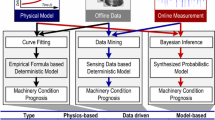Abstract
In order to improve the prediction accuracy of non-Gaussian data and build reasonably the prediction model, a novel residual life prediction method is proposed. A dynamic weighted Markov model is constructed by real time data and historical data, and the residual life is predicted by particle filter. The particles of the state vector are predicted and updated instantaneously using particle filter. The probability distribution of the predicted value is estimated by the updated particles. The residual life can be predicted using the set threshold of the state. This method improves the accuracy of residual life prediction. Finally, the advantage of this proposed method was shown experimentally using the bearings’ full cycle data.











Similar content being viewed by others
References
Baraldi, P., Compare, M., Sauco, S., et al. (2013). Ensemble neural network-based particle filtering for prognostics. Mechanical Systems and Signal Processing, 41(1), 288–300.
Çaydaş, U., & Ekici, S. (2012). Support vector machines models for surface roughness prediction in CNC turning of AISI 304 austenitic stainless steel. Journal of Intelligent Manufacturing, 23(3), 639–650.
Chao, P. Y., & Hwang, Y. D. (1997). An improved neural network model for the prediction of cutting tool life. Journal of Intelligent Manufacturing, 8(2), 107–115.
Chen, X., Shen, Z., He, Z., et al. (2013). Residual life prognostics of rolling bearing based on relative features and multivariable support vector machine. Proceedings of the Institution of Mechanical Engineers, Part C: Journal of Mechanical Engineering Science, 227(12), 2849–2860.
Chen, C., Vachtsevanos, G., & Orchard, M. E. (2012). Machine residual useful life prediction: An integrated adaptive neuro-fuzzy and high-order particle filtering approach. Mechanical Systems and Signal Processing, 28, 597–607.
Gebraeel, N. Z., Lawley, M. A., Li, R., et al. (2005). Residual-life distributions from component degradation signals: A Bayesian approach. IIE Transactions, 37(6), 543–557.
Hartigan, J. A., & Wong, M. A. (1979). Algorithm AS 136: A k-means clustering algorithm. Applied Statistics, 100–108.
Kharoufeh, J. P., & Cox, S. M. (2005). Stochastic models for degradation-based reliability. IIE Transactions, 37(6), 533–542.
Kharoufeh, J. P., & Mixon, D. G. (2009). On a Markovc—Modulated shock and wear process. Naval Research Logistics (NRL), 56(6), 563–576.
Kimotho, J. K., Sondermann-Woelke, C., Meyer, T., et al. (2013). Machinery prognostic method based on multi-class support vector machines and hybrid differential evolution-particle swarm optimization. Chemical Engineering Transactions, 33, 619–624.
Liu, Q., Dong, M., & Peng, Y. (2012). A novel method for online health prognosis of equipment based on hidden semi-Markov model using sequential Monte Carlo methods. Mechanical Systems and Signal Processing, 32, 331–348.
Ng, S. S. Y., Xing, Y., & Tsui, K. L. (2014). A naive Bayes model for robust residual useful life prediction of lithium-ion battery. Applied Energy, 118, 114–123.
Orchard, M. E. (2007). A particle filtering-based framework for on-line fault diagnosis and failure prognosis. Atlanta: Georgia Institute of Technology.
Pitt, M., Silva, R., Giordani, P., et al. (2010). Auxiliary particle filtering within adaptive Metropolis–Hastings sampling. arXiv preprint arXiv:1006.1914.
Tian, Z. (2012). An artificial neural network method for remaining useful life prediction of equipment subject to condition monitoring. Journal of Intelligent Manufacturing, 23(2), 227–237.
Tobon-Mejia, D. A., Medjaher, K., & Zerhouni, N. (2012). CNC machine tool’s wear diagnostic and prognostic by using dynamic Bayesian networks. Mechanical Systems and Signal Processing, 28, 167–182.
Wang, Y., Deng, C., Wu, J., et al. (2013). Failure time prediction for mechanical device based on the degradation sequence. Journal of Intelligent Manufacturing, 13, 1–19.
Yan, J., Guo, C., & Wang, X. (2011). A dynamic multi-scale Markov model based methodology for residual life prediction. Mechanical Systems and Signal Processing, 25(4), 1364–1376.
Yaqub, M. F., Gondal, I., & Kamruzzaman, J. (2013). Multi-step support vector regression and optimally parameterized wavelet packet transform for machine residual life prediction. Journal of Vibration and Control, 19(7), 963–974.
Acknowledgments
The work described in this paper was supported by a Grant from the national defence researching fund (No. 9140A27020413JB11076).
Author information
Authors and Affiliations
Corresponding author
Rights and permissions
About this article
Cite this article
Zhang, S., Zhang, Y. & Zhu, J. Residual life prediction based on dynamic weighted Markov model and particle filtering. J Intell Manuf 29, 753–761 (2018). https://doi.org/10.1007/s10845-015-1127-4
Received:
Accepted:
Published:
Issue Date:
DOI: https://doi.org/10.1007/s10845-015-1127-4




